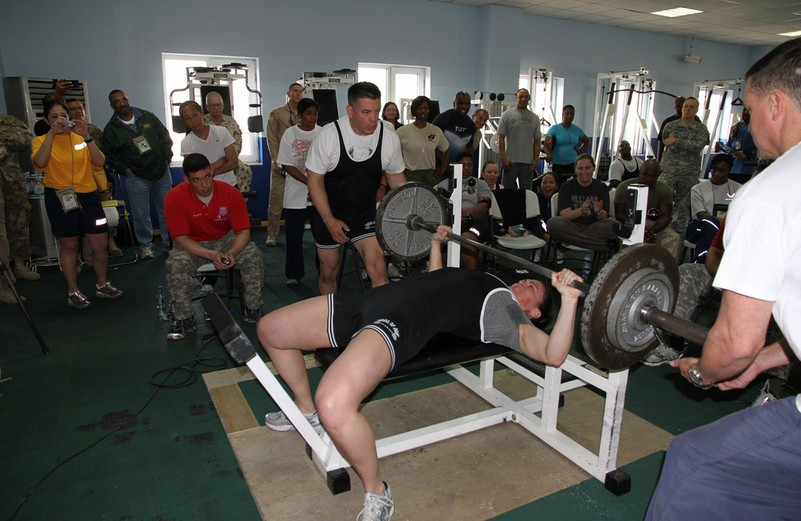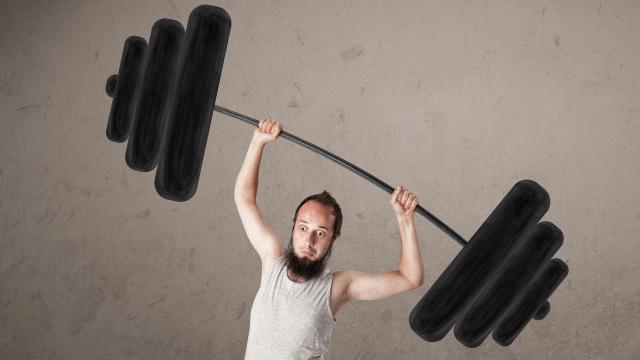If you’re a self-described “skinny” person trying to put on weight, you probably feel like a second-class citizen when you’re researching on the internet. Most fitness information is geared towards fat loss. Let’s talk about the basics of healthy weight gain.
My friend Tynan approached me one day asking about fitness. We’ve talked about how fitness success depends heavily on habit, which is why it was surprising when Tynan, a expert and prolific author on habits, came to me looking for advice.
“No matter how much I eat, I can’t put on weight. Seriously, I went on a cruise one time”¦ they’re all you can eat, so I just stuffed myself silly. I put on about five pounds by the end, but within a few weeks I was back to my starting weight.”
To people who are predisposed to being overweight (like myself), this sounds almost like some voodoo, foreign magic. But naturally skinny folks have experienced this throughout their entire life. You’ll find the particular fitness skill that’s most important to you depends on your starting point and your goals. While habit is one of the most important skills for people who are losing weight, naturally lean folks will rely more heavily on the “knowledge” facet. Let’s see why.
Why It’s So Difficult For Skinny People To Put On Weight

In the late 1960’s, a group of researchers went to the Vermont State Prison and asked for volunteers. The researchers sought to overfeed prisoners with a normal body mass index (i.e. not classified as overweight) until they increased their body weight by 25%, and then study the impact of weight gain.
Simple, right? It should have been, except for one astonishing fact: some prisoners could not gain weight, no matter how much they were overfed. One participant increased his caloric consumption up to 10,000 calories per day and still could not increase his body weight more than 18%. When the experiment concluded, the prisoners had no problem returning to their original weight.
This research inspired a recent BBC documentary that corroborated the prisoners’ — and Tynan’s — experiences. Naturally skinny people seem to be biologically programmed to stay at a given weight. Here are some of the reasons that weight gain was so difficult:
- Subjects avoided calories once their weight was uncomfortably high. They literally could not finish all of their meals.
- There was an increase in resting metabolic rate due to the increase in lean muscle
- While not discussed in the documentary, it’s well documented that Non Exercise Adaptive Thermogenesis (or NEAT for short) creates a “protective” effect against weight gain during times of overfeeding.
Train, Don’t Exercise

What does it mean to gain weight in a “healthy” manner? We asked Dr Spencer Nadolsky, an osteopathic physician who specialises in helping obese patients. Dr Nadolsky says:
One can put on weight in a healthy manner if the weight is lean mass. Body fat percentage is a much better indicator than BMI when it comes to predicting health outcomes. It’s also important to keep waist circumference low, since that’s a surrogate for visceral fat which puts you at a higher risk for heart disease.
Dr Nadolsky, by the way, is also a competitive amateur bodybuilder who would likely be classified as “obese” on the BMI scale.
OK, so to put on “healthy” weight, one must gain muscle. The best way to do that is to train rather than exercise.
It’s typical to think of the word “exercise” when it comes to being active. Exercising, however, implies activity in order to intentionally burn calories. But additional caloric burn is the last thing that people need in order to put on weight. The word exercise also doesn’t imply progression, which is needed to build muscle.
Building muscle requires something called “progressive overloading“. This is just a fancy way of saying that you’ll need to strength train with increasingly high weight, reps, or volume during subsequent sessions. This allows muscular hypertrophy, the increase in skeletal muscles, to occur. Hypertrophy also increases your capacity to store muscular glycogen, or glucose stored within your muscles. This glucose is stored within water, further leading to an increase in healthy weight.
Luckily, there are some pretty good workouts available that focus on progressive overloading. Some examples are:
- Starting Strength
- Reverse Pyramid Training
- Stronglifts 5×5
- JC Deen and Jordan Syatt’s Muscle Guide for Beginners (which also includes diet instructions)
Back to Tynan’s story. I put him on a custom workout focusing on progressive overload and he immediately found that for the first time, he actually retained the weight he gained. Training was only one part of the equation, however. Changing his diet was the bigger challenge.
Eat More Calories
If you have the training part of the equation down pat, and your weight isn’t going up, then you’ll simply have to consume more calories. This is the biggest problem that I’ve seen with hardgainers — some people have great difficulty eating enough calories to increase lean mass. From Lyle McDonald’s Body Recomposition blog:
Outside of poor training (which can be either too much or too little), not eating enough is the number one mistake I see most trainees making who can’t gain muscle. This is true even of individuals who swear up, down and sideways that they eat a ton but no matter what they can’t gain weight.
Almost invariably, when you track these big eaters, they really aren’t eating that much. Research has routinely shown that overweight individuals tend to under-estimate food intake (e.g. they think they are eating much less than they actually are) but in my experience ‘hardgainers’ are doing the opposite: vastly overestimating how much they are actually eating in a given day, or over the span of a week.
Similarly, although such trainees may get in a lot of food acutely, invariably they often compensate for those high-caloric intakes by lowering calories on the following day (or even in the same day). So while they might remember that one big-assed lunch meal, they won’t remember how they ate almost nothing later in the day because they got full.
Remember, your body is constantly trying to maintain homeostasis. Even if you focus on eating more calories around breakfast, lunch and dinner, you may unintentionally reduce your caloric intake during other times without realising.
Find out how many calories you need in order to stay the same weight every day, and then increase your calories by 15%. You can do this easily by adding calorically dense foods into your diet, such as adding a few glasses of whole milk into your diet every day or a tablespoon or two of olive oil into your meals.
Here’s a list of calorically dense foods that are easy to incorporate into your diet.
- Olive oil (130 calories per tablespoon)
- Peanut butter (190 calories for two tablespoons)
- Dark chocolate (250 calories for ¼ of a bar)
- Avocados (230 calories for one whole avocado)
- Whole milk (200 calories for two cups)
- Raisins (250 calories in half a cup)
You’ll also need to make sure that you get 0.75g of protein per pound that you weigh (which roughly translates to 1.5 grams of protein per kilo).
I had Tynan eat the same meals repeatedly for the first few weeks in order to ensure that he was in a caloric surplus (that is, consuming more calories than he burned every day). This was difficult at first, and many times he had to force himself to eat. If this sounds unnecessarily difficult, remember that folks who want to lose weight have are just as uncomfortable eating less than they desire; you’re just approaching this from the opposite end of the spectrum.
The result? Within a year, Tynan had put on 20 pounds (9 kilograms) while maintaining the same waist measurements.
Where To Go From Here

So, with that in mind, let’s summarise what you need to do in order to put on weight:
- Pick a strength regimen that emphasises progressive overload. The exact program doesn’t matter too much. Just stick to something.
- Figure out your “maintenance calories”, the amount of calories that you need in order to maintain the same weight, then increase this amount by 15%. You can calculate your maintenance calories by logging your daily food intake (assuming you have been the same weight for a while) or using an online calculator like this (use the body fat percentage option for more accurate results).
- Remember that you might need to force yourself to eat even when you’re not hungry. You can do this through calorically dense foods, such as olive oil. Adding just two tablespoons of olive oil to your meals will net you 250 calories more.
- Make sure to consume at least 1.5 grams of protein for every kilogram that you weigh. You can consume more, but it might not do anything if you are on a caloric surplus.
- Track your weight and waist measurements weekly. If you find that your waist measurements are increasing too quickly, lower your caloric intake.
Anecdotally, the best thing about being a “skinny” person who can’t put on weight is that they tend to stay lean. This means that with a changes to your diet and training, you can sport a lean, muscular physique. Just don’t show it off to your friends like me who are naturally on the chubby side or you’ll be “that guy” (or girl).
This story has been updated since its original publication.

Comments
5 responses to “How To Build Muscle When You’re Naturally Skinny”
One thing people often overlook is that it’s vital for a long time skinny person to do a balanced workout. It’s true for everyone but it’s even more important when you’re skinny because your body probably isn’t starting in a condition where a truly balanced workout is possible. When you’ve been underweight your entire life certain muscles aren’t used to having anything more than the weight of your (light weight) body on them. You’re starting out weak enough that the minimum increments actually make a noticable difference.
While I’m generally against machine assisted training because it’s too focused, I know a lot of people with zero practical strength because they’ve used machines exclusively, but when you’re skinny and just starting out free weights can be a real struggle to control. If that’s the case try figuring out exactly where the failure lies and focusing on that area with a machine. You’ll need professional help to do this. Although it can be a little hard to explain what you’re trying to achieve because they’re used to people coming in who might not have a balanced body but still have supporting muscles that can handle more than the weight of the bar.
When you make a gain there go back to whatever free weight exercise you were trying to do and see what impact it made. If you were right you should now be at a point where when performing that exercise the problem area doesn’t hit it’s limit long before anything else. From there it’s a lot easier to make progress using traditional methods. Plus while it’s a bit embarrassing to admit that you’re struggling with feather weight lifting overcoming that first hurdle feels a lot more significant on a personal level which is really encouraging.
Stick to compound movements – bench press, squats, deadlifts, etc.
“You’ll also need to make sure that you get 0.75g of protein per pound that you weigh (which roughly translates to 1.5 grams of protein per kilo).”
If you’re strength training you will want more than that 1 – 1.5 g of protein per pound of body weight
Have you got a citation for the 1-1.5g/lb?
There was a meta-analysis out a few months ago which quite conclusively showed that 0.7g/lb is the sweet spot, and there is no additional benefit after about 0.9g/lb. I can find the link if you’re interested. If you have trouble gaining weight, carbs are likely to be better for weight gain than additional protein.
No, if you’re cutting that’s what you want to aim for.
As a previous hard-gainer/small-eater, my personal experience was that to continue to eat small, but more frequently with the net effect of an increased calorie intake. Mostly by interspersing high-protein drinks between main meals to reach my daily calorie target. I also suspect the body’s absorbtion of a high-calorie diet in three meals is poor, and especially doomed if you’re not a natural scoffer.
Finally – other aspects of your life can impact. I had to get my asthma under control as it was burning a lot of calories. I was eating for two there for a long while!
You probably should check your links still work before reposting an article.